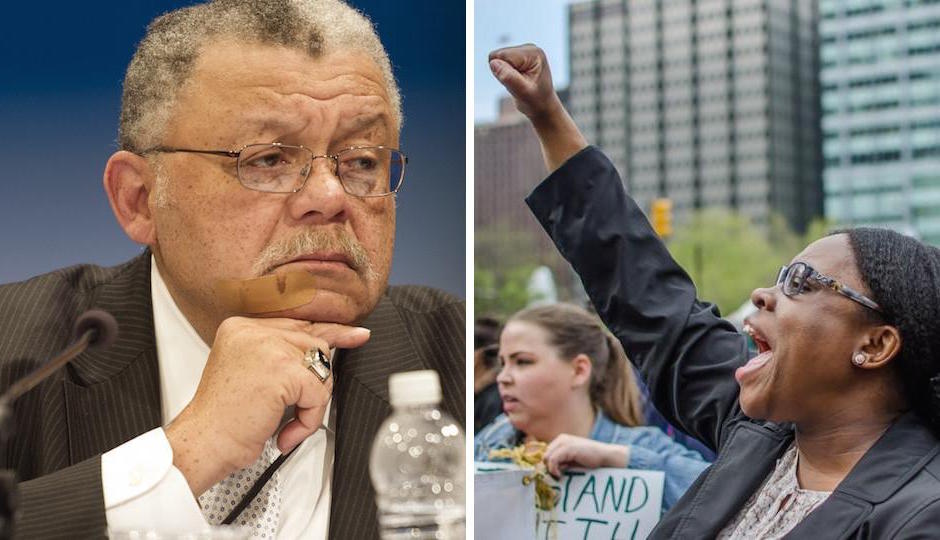How Philly Police Kept the Peace at “Philly Is Baltimore”

Left: Commissioner Charles Ramsey | AP photo. Right: A scene from Thursday’s Philly Is Baltimore protest. | Joshua Albert photo.
Well, thank God for Philadelphia Police.
I’m serious.
Yes, it’s easy to find reasons to criticize our local department, and I do it all the time. It’s also easy to watch some officers become martyrs to our streets and then give the rest of them a free pass, or something close to it. But I’m interested in doing something else today: I want to praise the Philadelphia Police Department for a bit of smart policing, done professionally, and in a fashion that has served the community very well indeed.
Simply put: The department has done a fantastic job of handling the “Black Lives Matter” protests that have occurred here regularly since Michael Brown was shot in Ferguson, Missouri, last year. And it’s done so under trying circumstances — as an object of the protests.
That means officers have come face-to-face with protesters who have (occasionally) cursed them and flipped them off. It’s easy to see how such situations could become tense, could easily give themselves over to the kinds of ugliness that afflicted similar protests in Baltimore and New York last week.
Instead both protesters and officers have largely kept their cool. Which means that in Philadelphia — for now anyway — peace has reigned and arrests have been minimal. That’s a great, laudable accomplishment, and the police deserve a good deal of the credit for it. (Chief Inspector Joe Sullivan, who has directly overseen many of the protests, including Thursday’s, by all accounts deserves some personal credit, as well.)
“The philosophy is to make no arrests if we don’t have to,” Commissioner Charles Ramsey told me this week, after the hubbub of last Thursday’s #PhillyIsBaltimore march had died down. “Most people who want to come out to protest want to do so peacefully.”
Even before talking to Ramsey, several facets of the department’s approach to protesters were plain to see:
• Officers have been instructed to protect the protests, not confront them: Going back to the “Occupy Philly” days of 2011, Philly officers have been given frequent reminders that protesters have a First Amendment right to gather and peaceably protest.
• Officers have been instructed to absorb some abuse, rather than escalate any minor incidents into major ones: There was a tense moment Thursday, reportedly when an officer got his hat knocked off by a protester and some arrests were made, that could’ve led to a larger, uglier confrontation. Instead, the moment passed. “We had an officer with a busted lip,” Ramsey said. “You can’t overreact to this stuff. There’s certain types of things you absorb as best you can.”
• Police have dressed like police rather than for battle: Pictures from Baltimore showed phalanxes of police officers in riot helmets and brandishing shields, ready for physically violent confrontation with protesters. Here? Protesters were surrounded, to a great extent, by bike cops in short pants. “If we look like we’re going to fight,” Ramsey observed, “the crowd is going to react negatively.”
• Protesters have been allowed to march pretty much any public place they want — with an exception. The exception? The highway. That one rule has probably saved a few protesters from being run over by a car going 60 mph. In New York, conversely, protesters at Union Square were arrested as soon as they left the sidewalk for the street. The result? One-hundred-forty-three arrests.
(There are some Philadelphians, vocal in online comments sections, who seem to advocate for the New York approach. Which would they prefer? The delayed commute caused by a peaceful, if sprawling, march — or the damage to lives and bodies, to property public and private, that a “tougher” approach might cause? Baltimore’s problems have not been caused by a lack of “toughness” by police, at all.)
Ramsey attributes the largely peaceful protests here to the protesters themselves. “My hat’s off to them,” he said. “If they didn’t have that mindset, none of the things we do on our end would make any difference. I think it’s on both sides.”
The department has its problems. Bad officers get their jobs back too easily. In other policing situations, force is used too often. The Brandon Tate-Brown case, now the subject of a civil lawsuit, looms as a challenge. That there are protests here isn’t entirely undeserved.
If we want good behavior from the police, though, we ought to recognize it when it happens and praise it to the heavens. So let’s repeat: Philadelphia Police have handled the post-Ferguson protests here about as well as could be hoped for, and deserve a big chunk of credit for keeping the peace.
Ramsey, though, shrugs off the praise when I suggest Philly might be a model to other cities facing similar protests.
“We take it one step at a time,” he said. “It’s not like things like that could not happen in Philly. It could happen anywhere. … If we’re not the story at the end of the day, that’s a success.”
Let’s hope the successes continue.
Follow @JoelMMathis on Twitter.


